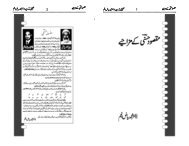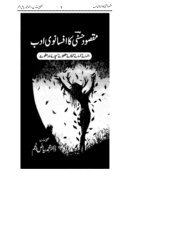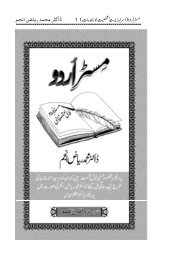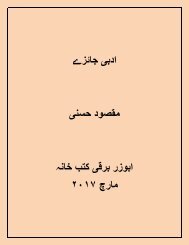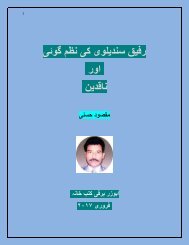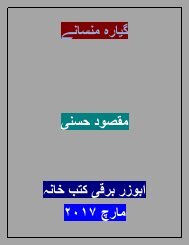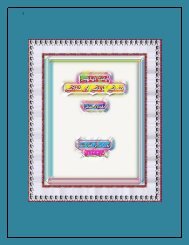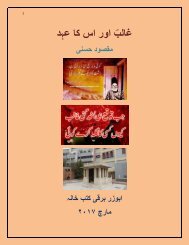Japani_ki_lisaniyati_Nazam_or_bhol_chal
You also want an ePaper? Increase the reach of your titles
YUMPU automatically turns print PDFs into web optimized ePapers that Google loves.
JPANI KA LASANIYATI NAZAAM AUR<br />
BOOL CHAL By Maqssoq Hasni<br />
78<br />
Compiled By: Dr. M. Riaz Anjum<br />
In case/if it gets late, please call.<br />
It is also used on written f<strong>or</strong>ms that ask f<strong>or</strong> the respondent's<br />
opinion:<br />
Anata no baai, means<br />
Aap kay khayaal main---<br />
In your opinion...<br />
To<strong>ki</strong><br />
To<strong>ki</strong> literally means "time" and functionally means<br />
something like "at the time<br />
of."<br />
(In fact, the kanji f<strong>or</strong> to<strong>ki</strong> is the same as that f<strong>or</strong> ji, meaning<br />
"hour" (like 2-ji, 2<br />
o'clock).] It can be hypothetical ("if") <strong>or</strong> actual ("when"), but<br />
is m<strong>or</strong>e likely to be used to mean "when".<br />
Baai and to<strong>ki</strong> are interchangeable, such as<br />
Omoi to<strong>ki</strong> = omoi baai = agar yah wazni hai if it's heavy...<br />
Kodomo no to<strong>ki</strong><br />
Jab mein bacha tha<br />
When I was a child<br />
Kodomo no baai<br />
Bacha honay <strong>ki</strong> surat main<br />
In case of children<br />
Ya<br />
In case you are a child.<br />
Agar tum aik bacha hotay<br />
HIRAGANA AND COMPOUND<br />
ARABIC SOUNDS<br />
Alam-e-Arab na’siraf apnay tarekhi, tehzibi, moashi aur<br />
saqafti hawalah se alalm-e insani <strong>ki</strong> jan hai balkah<br />
wasael-e-qudrat (khasusan petrol, shamsi tawani<br />
wagherah) kay moamlah main khasusi ehmiat ka hamil hai.<br />
Es kay tajarti moamlaat dunyaan <strong>ki</strong> tamam walaetoon se<br />
rahay hain. Aaj bhi mazi qareeb-obaed <strong>ki</strong> tara surat-e-hal<br />
mukhtalif nahain. Ta’hum tajarti omo<strong>or</strong>-o-moamlaat aur<br />
39<br />
JPANI KA LASANIYATI NAZAAM AUR<br />
BOOL CHAL By Maqssoq Hasni<br />
Compiled By: Dr. M. Riaz Anjum<br />
than the listener<br />
Toire wa koko de wa arimasen.<br />
The toilet is not here.<br />
Soko (there, that place) - indicates locations near the<br />
listener than the speaker. It<br />
also indicates a relational proximity to the listener, not<br />
always a physical<br />
proximity.<br />
Hachi wa soko desu yo!<br />
The wasp is right there, by you!<br />
Asoko (over there, that place over there) - is used f<strong>or</strong><br />
places that are at a distance from both the speaker and<br />
listener.<br />
Keisatsu-kan wa asoko desu ka?<br />
Is the police station over there?<br />
Doko (where) - fits into this class as well and is used to ask<br />
questions.<br />
Toire wa doko desu ka?<br />
Where is the toilet?<br />
The w<strong>or</strong>ds k<strong>or</strong>e, s<strong>or</strong>e, are are used to point out objects<br />
(sometimes people) in different locations in reference to the<br />
speakers.<br />
K<strong>or</strong>e is used f<strong>or</strong> items closer to the speaker than the<br />
listener: this.<br />
S<strong>or</strong>e is used f<strong>or</strong> items closer to the listener than the<br />
speaker: that.<br />
Are is used f<strong>or</strong> items at a distance from both the speaker<br />
and the listener: that<br />
over there.<br />
Baai<br />
Baai isam (noun) hai. Jahaan in case of... ya in the case<br />
that... kehnay <strong>ki</strong> zar<strong>or</strong>at hoti hai wahaan es ka estamal <strong>ki</strong>ya<br />
jata hai. Maslan<br />
Osoku naru baai, renraku shite kudasai.<br />
Dair ho janay <strong>ki</strong> surat main call kar lain.<br />
77




